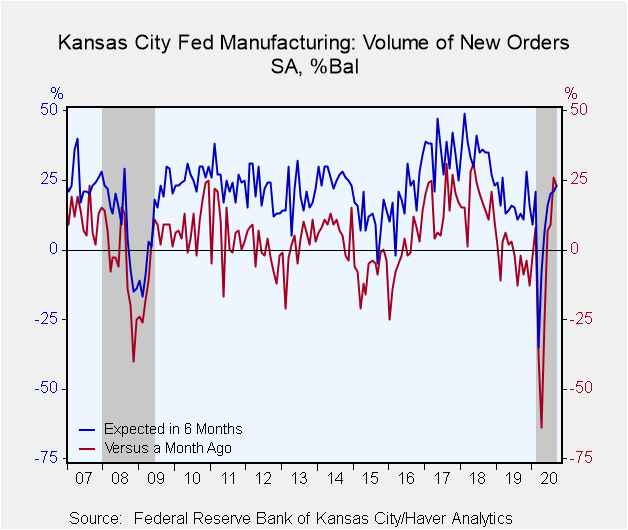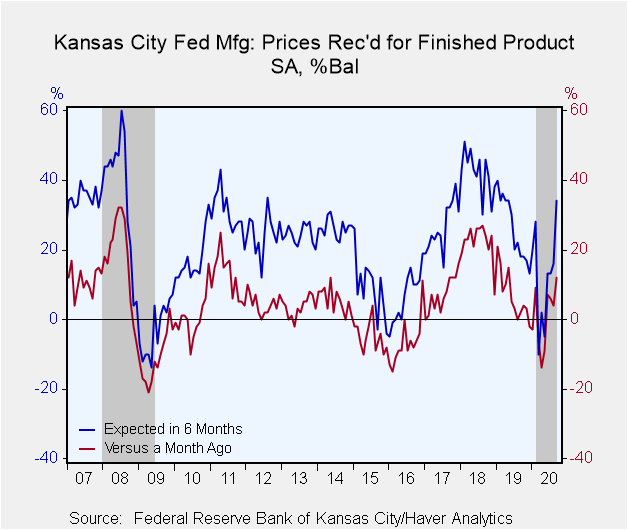 Global| Sep 24 2020
Global| Sep 24 2020Kansas City Fed Factory Index Eases in September
by:Tom Moeller
|in:Economy in Brief
Summary
• Expectations also weakened slightly. • Pricing power improved. The Federal Reserve Bank of Kansas City reported that their manufacturing sector business activity index fell to 11 in September after increasing to 14 in August. These [...]
• Expectations also weakened slightly.
• Pricing power improved.
The Federal Reserve Bank of Kansas City reported that their manufacturing sector business activity index fell to 11 in September after increasing to 14 in August. These figures remained up, however, from the low of -30 in April.
The Kansas City measure is a diffusion index with positive readings indicating more respondents reporting increases than decreases in business activity. The composite index is an average of the production, new orders, employment, supplier delivery time, and raw materials inventory indexes.
The ISM-Adjusted Index (NSA) was little changed at 54.9 after rising to 55.0 in August. It remained up from a low of 37.6 in April.
A decline in the current conditions measure was broad-based with new orders, shipments, employment and production backpedaling. These measures remained up sharply, however, from their recession lows. The supplier delivery speed measure rose, in contrast, indicating slower delivery speeds.
On the inflation front, the prices received index for finished products surged to 12, the highest level since May 2019. The raw materials index also jumped to 24, the highest level since January.
The future composite index (expectations in six months) eased to 18 from 19 in August. Nevertheless, it remained up sharply from September of 2019. Expected employment declined, but most of the other expectations series improved, including production, shipments and new orders.
Expectations of pricing pressures intensified. The finished product price measure rose to 34, its highest level since May 2019, and the raw materials price measure increased to 33, up from -8 six months earlier.
The diffusion indexes are calculated as the percentage of total respondents reporting increases minus the percentage reporting declines. The September survey was conducted during the third week of the month and included 95 responses from plants in Colorado, Kansas, Nebraska, Oklahoma, Wyoming, northern New Mexico and western Missouri. Data for the Kansas City Fed Survey can be found in Haver's SURVEYS database.
| Kansas City Federal Reserve Manufacturing Survey (SA) | Sep | Aug | Jul | Sep'19 | 2019 | 2018 | 2017 |
|---|---|---|---|---|---|---|---|
| Conditions Versus One Month Ago (% Balance) | 11 | 14 | 3 | -1 | 0 | 17 | 14 |
| ISM-Adjusted Composite Index (NSA) | 54.9 | 55.0 | 51.5 | 49.4 | 50.0 | 58.9 | 56.7 |
| New Orders Volume | 23 | 26 | 9 | -2 | -3 | 17 | 17 |
| Number of Employees | 7 | 9 | 3 | -10 | -1 | 17 | 15 |
| Production | 18 | 23 | 7 | 9 | 2 | 19 | 17 |
| Prices Received for Finished Product | 12 | 4 | 6 | 2 | 7 | 22 | 7 |
| Expected Conditions in Six Months | 18 | 19 | 14 | 6 | 12 | 28 | 26 |
| New Orders Volume | 23 | 21 | 20 | 13 | 17 | 35 | 35 |
| Number of Employees | 19 | 26 | 11 | 14 | 15 | 33 | 39 |
| Production | 25 | 20 | 25 | 7 | 19 | 40 | 40 |
| Prices Received for Finished Product | 34 | 16 | 13 | 18 | 26 | 42 | 27 |
Tom Moeller
AuthorMore in Author Profile »Prior to joining Haver Analytics in 2000, Mr. Moeller worked as the Economist at Chancellor Capital Management from 1985 to 1999. There, he developed comprehensive economic forecasts and interpreted economic data for equity and fixed income portfolio managers. Also at Chancellor, Mr. Moeller worked as an equity analyst and was responsible for researching and rating companies in the economically sensitive automobile and housing industries for investment in Chancellor’s equity portfolio. Prior to joining Chancellor, Mr. Moeller was an Economist at Citibank from 1979 to 1984. He also analyzed pricing behavior in the metals industry for the Council on Wage and Price Stability in Washington, D.C. In 1999, Mr. Moeller received the award for most accurate forecast from the Forecasters' Club of New York. From 1990 to 1992 he was President of the New York Association for Business Economists. Mr. Moeller earned an M.B.A. in Finance from Fordham University, where he graduated in 1987. He holds a Bachelor of Arts in Economics from George Washington University.










